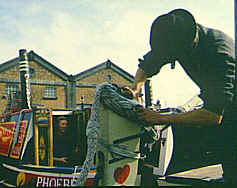Canal Art – Decorative Ropework
The decorative ropework tradition of canal boats was the combination of cultural need for some strictly practical demands with the boatman’s elaboration, coupled with the ready availability of the right material at a price the boatman could afford. The practical need was primarily fendering, something soft and resilient between the boat and the lock wall, or something to protect the house-proud skipper’s elaborate paintwork from damage.
Big tough fenders had to be made and fitted to the bows of any boat when working locks, and a big set of stern fenders was needed on a motor boat to soften the bumps of the towed butty boat running into the motor boat’s stern, in bridges or shallow places. A thick plait of rope was worked round the very top of the big wooden horse boat rudder to protect the paint, and several small plaits or ‘turks heads’ encircle the wooden tiller to save it from damaging the cabin roof.
These were practical needs being fulfilled in a logical way with waste rope, and a neat craftsman and a tidy boat captain ensured that these fenders always looked neat and tidy, all properly ‘ship shape’ in nautical parlance.
There were however many other pieces of decorative ropework on a well furnished narrow boat which, whilst probably originally invented for functional reasons, gradually became simply decorative additions. Short ropes with fancy knitted ends dangled down the cabin sides and from the watercan and the chimney, and pretty tubes of knotted ropework adorned with more turks heads plaits were strained taut down the back of the rudder. Ropes originally tied over a folded tarpaulin top cloth to stop it blowing away became permanent neat geometric designs in rope, with the spare ends coiled and tucked under the tight white ropework lines like little wheels.
The ropework was white because it was cotton, and it was cotton because that was the best available material for the horse boat towing lines. They had to be strong, but have sufficient elasticity to equalise the jerking of the horses’ movements into a steady cumulative pull at the mast.
However, these lines wore out very quickly, constantly rubbing against the brickwork of locks and bridges, and a working horse boat would need a new one every week or two, leaving masses of short, part-worn pieces of line to make tying-up ropes, or provide the raw material for fiddly decorative ropework to pass the time of an idle evening. When scrubbed a few times with clean water these rope designs would dry out “as white as the driven snow”, highlighting the paintwork and providing yet another layer of pattern to the narrow boat’s palette of designs.
The total number of knots and hitches used on the canal was not great, but repetition was the key to their decorative effectiveness. Big fenders are covered with a tight network of half hitches, whilst pretty little ones for the butty rudder might be woven round a core with a pattern like a spider’s web, or built out as a tight coil held in place with strands tucked through the lay of the rope.
Much use is made of continuous wall-knotting to create a decorative knitted end to a rope, working the three strands back over the standing part as a core, finally tucking them back through the lay of the rope like a splice.
The same principle, using six strands worked back over a long eye splice, finished off with a turks head, results in a purely ornamental ropework pendant to hang from the towing mast when not in use, the ‘mast dropper’, and continuous wall knotting produces the graceful ‘swans neck’ tube of ropework for the back of the rudder mentioned previously.
The effect of all these knitted strands and patterns of white rope on the outside of the boat is not dissimilar to that of the thick crochet work done by the boat woman for her cabin interior, both clearly parts of a related family of handicrafts that beautified the boat family’s home and workplace, and gladdened the heart. Even the horse sometimes had crocheted ear caps to keep the flies out.
All materials and images © Canal Junction Ltd. Dalton House, 35 Chester St, Wrexham LL13 8AH. No unauthorised reproduction.
About | Terms | Privacy| Refunds & Returns| Sitemap | Contact Us
With over 800 pages, this website uses cookies to record visitor behaviour using Google Analytics. More information on Privacy Page. Page last updated: 31/03/2025.





Back to Menu....
Canal Heritage >>